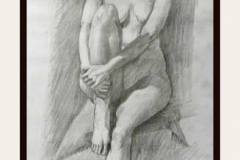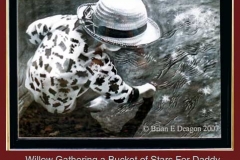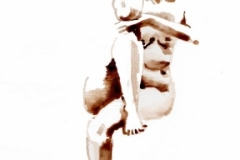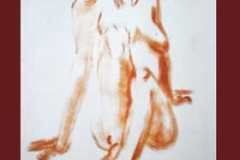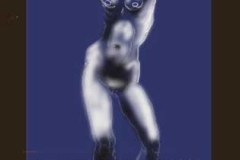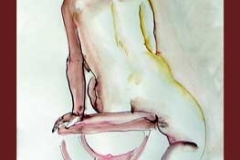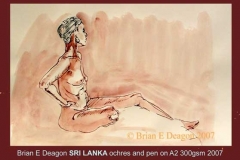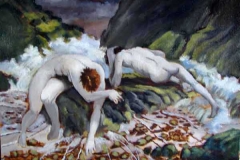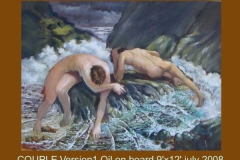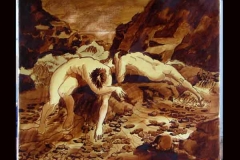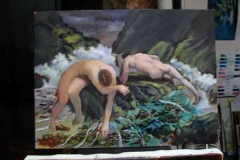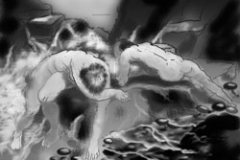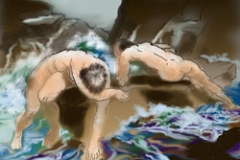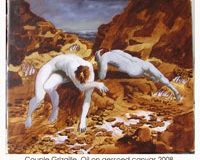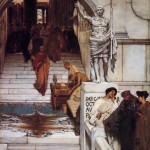Visiting the Northern Territory of Australia gave me a contact with a people whose ancestors have inhabited the land for 60000 years . It would be a stupid mistake to assume that in that time, their culture ( cultures?) remained static. In fact , to assume only one Aboriginal culture , is based on ignorance, and is deeply insulting, if not overtly racist.The assumption is that the single culture remains static because the “primitives” lack the ability to change,learn,”progress”,or diversify.Nothing could be further from the truth.The very idea of progress is (was) central to my culture, but need not therefore assume the status of an absolute virtue or value for another.
“Progress? Maybe something,maybe nothing.”
What I learned was that I had a culture too. Seems obvious until you begin to ask ” What are the key concepts of my culture? How does my culture differ from yours?” “Is my culture changing?”
I eventually realised that I was a child of my time. I had been shown Western European culture through the prism of Modernism. Even my view of the Renaissance was based on the “ladder theory”;
“Every artist builds on the one prior. Every change is a progression onward and up.”
I know now that the paintings and artists were chosen to illustrate this theory. And if your work couldnt be made to fit the theory, it was relegated to the stock rooms.It never made it to the school library!
This view of art history is still the official view.Its simplistic,easily understood, and since we have had a couple of generations whose “history” of art begins with Andy Warhol, its not likely to change next week. “Transgressions” I believe is the new onward and up,and urinating on patrons to the acclaim of critics is the top rung of the ladder.This week. The ladder theory worked well until someone noticed the snakes.
There is an alternative view. A much deeper and richer history, and it is alive and well,or at least variable in its outcomes. Most usefully, it is based on the craft of drawing and painting with its roots in the Renaissance. I am very aware that this craft does not always result in art, and the works are often mundane, even boring. Knowing the “how” does not tell us “what” to paint.Annigoni referred to himself as a “painter”, not an “artist”.
One consequence of abandoning the inevitability of a bigger,better,brighter future is to begin to suffer a nostalgia for a Golden Age in the past. Got nymphs flitting around in your top paddock? Getting deja vu again?
The fact that Impressionism has been the orthodoxy for almost two centuries shows if nothing else that the popular imagination wont abandon the figurative. But art education did. The artists who persisted with a study of anatomy,light,colour,and perspective drew comic books and animations in spite of their teachers! Frank Frazetta rules, Conan is King! But hang on, isn’t this the very nostalgia…….and adolescent “tits and bums”art that gave us thousands of rescued maidens by hundreds of artists that Modernism rejected?
Yes. It is. And its persistence should tell us something. In fact its not surviving ,but thriving in computer driven graphics.And in order to produce that, you still need to be able to draw , if not paint. In fact , the drive to produce more intense realism in animation is part of the revival of academic technique.
Ingres , Gerome,Nera Simi, Annigoni,Lance Bressow took me back to Florence. David,Lefebvre, Bougereau, then across the Atlantic from Paris to Boston and Tom Ouellette. Throw in the Dutch connection, and there is a deep vein running from Europe to America. Speed and Bridgeman in drawing, Graves ,Sargent and others trained in the ateliers of nineteenth century Paris. Deeply conservative, this is a rich vein of ……..dare I say it?……..culture. Realist traditions are alive and living in America. And almost by accident,I have become an heir to these traditions.
The antipathy toward Bougereau seems to stem from his leadership of the French Academy.He seems to have been hardworking and “a nice guy”. What is forgotten is that he himself resigned when his suggestion that new and unacclaimed artists should be the focus of the prizes and medals, was itself rejected.He was also one of the most successful artists financially. I have seen an original Bougereau, and it was stunning. Most criticism that begins “Its only……”seem to come from people who know bugger all about the craft of painting and even less about drawing.
Bargue and Gerome produced a systematised curriculum designed to revitalise French artisans,and were central to the work of Picasso and Van Gogh among their generation.There is another “history” to be written here.And lessons to be learned.
Studying Richard Hatton’s Figure Drawing is to be given the observations of generations of teachers and artists. The same applies to Bargue and Gerome’s book. To ignore this collective (and collected)wisdom is an act of anticulture, almost barbarism.( Yes, I know the barbarians cop a bad press.) It is simply not possible to make all those thousands of observations on your own, unguided; heroic and romantic visions of genius and new paradigmatic ideology and Ayn Rand notwithstanding!
There is a world of difference between “creativity strategies” such as wrapping, framing, gridding, decontextualizing, markmaking, disrupting, interrogating,recontextualizing, layering, metamorphing,collaging,referencing, oh! and transgressing etc; and learning the craft of an art form. Unfortunately,the need for funding of art education has driven an intellectualization of course content to “compete” with other disciplines.Bit stupid really,since good drawing IS an intellectual activity. Baby is gone with the bathwater,down the contemporary relevance plughole!
And so to the 10 tone “strings of colour” that I am learning from Tom Ouellette here in Boston. For me they are a key to a mansion. Only a key, but vital knowledge for giving my figures a palpable physical presence I have been seeking.
Deriving from(apparently)Jacques Louis David’s adoption of a “Venetian” palette, it has been systematised into four “strings ” of ten tones . These “strings” are a red earth, a yellow earth, a neutral gray, and a pink based on alizarin. Each string has ten tones, hence a palette consisting of forty “flesh tones”. A bit over the top? Yeah, but the idea is beautiful. And you need a bloody big palette to hold it all. And after you master that ( if anyone ever can), then you still have all the problems of contemporary relevance and “invention” to deal with.
Now at this point its necessary to point out that “tones” was not part of the artists language till the Nineteeth century.Prior to that was “chiaroscuro”, that useful device of light against dark. ” Truth to nature” was not an issue.I draw attention to this only to point out how we continually misjudge the intentions , methods , and vision of artists of the past. And how we must take everything with a grain of salt : taste, test and swallow only when palatable.
There is another dimension to all these “tones”. Shadows must remain transparent, half tones translucent, and lights opaque. This advice comes as far back as Cennino Cennini in the Fourteenth Century, and its probably more important than anything that came since.
So here I am. Halfway up or down another ladder. I may not be making much progress, but I’m not going to step on a snake!
Brian Deagon
Boston MA USA. 19/11/2007
Related Images:
